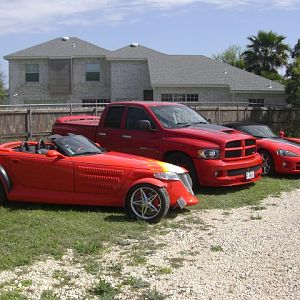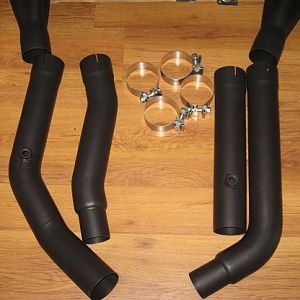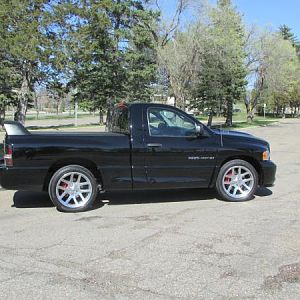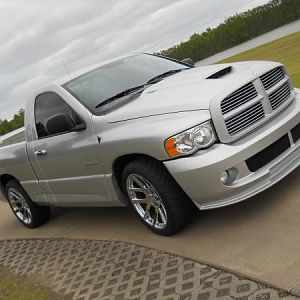robwclark
Full Access Member
Yo peoples, I have checked prior post and cant find where any of you have ever talked about how heavy these trucks are, and the desperate need of a load controler when dynoing these trucks. Now I know what I am about to say is common knowledge with some of you seasoned modders, but most people may not understand this very serious problem.
The problem: Your "average joe's" dynojet dynometer will almost never have a load control, and come from the factory set up to test & tune your average 3000-4000lb vehicle.
Why its a problem: When we place our 5000-6000lb trucks on the dyno, sure we can run the piss out of them and do all the testing and tuning we want, and get some seriously awesome numbers. BUT - We then go to the track, and very commonly we just cant seem to get the truck to run like it should, or show a trap speed consistant with the numbers it made back at the dyno. Now if you are tuned 100% perfect, and only want to see how much you can put down, go ahead and dyno all you want, the dyno wont lie. The problem is when we actually tune these trucks on the dynojet. We set them up in 4th gear and run them all the way up to 6000rpm. The engine in 4th gear on a dyno, is having a massively easy trip compared to the same run done on the street. This same run on the street will probably not be near the same fuel & timing maps you just spent all afternoon working on when you dyno'd your truck. Add in other factors such as extra passengers, summer temps, uphill grade, or a load of sheetrock for that matter, and your timing & fuel maps will most certainly be way off the charts they were so perfectly tuned to on the dyno that thinks your truck is a 2000 Z28. HP & Torque #'s should be on the money, but the tune you have will most certainly not. Also, I am currently dealing with an issue on my truck that applies to my theory, and would be very confusing if I didnt understand load on the truck as it's dyno'd: My a/f ratio is VERY rich on the dyno, but as soon as pull it off and make a street run we are only slightly rich...hasnt anyone ever had this problem? The less resistance the dyno places on your truck compared to the street causes it to us more fuel on the street because the truck is under a much higher load than it was on the dyno. The dyno I have access to does not have a load control and this does post a problem for me. Its hard to find a dyno with a load control. Back in the 1995-1998 time frame the only dynojet in the country with a load control that I knew of was at DynoTech in Dallas. I remember Lingenfelter (LPE)coming down there and using this dyno to run his S-10 pro-mods all the way from Indiana because they didnt have a load controller on theirs. John Lingenfelter himself explained the basis of this thread to me at Texas Raceway in Kennedale TX, and he believed this info to be golden. At the time I had a 95 RT/10 Viper car and this didnt apply to me much, but now that I mod these 5500lb trucks, this info is something to be seriously considered, and compensated for.
The possible fix: Make sure if you are doing any extensive tuning on a 5500lb brick, that you do it on a dyno with a load control, or tune it on the street without a dyno and simply go for 12:1 a/f all the way across the revband. With a load control, you can enter the weight of the truck, and the dyno will place said drag on the barrels, and make it harder for your truck to rev up in 4th gear resulting in a much closer street value to tune with. If you dont have access to a load-controlled dyno, then do like me, and try to make every attempt to tune your truck with compensation for the true street that you will be driving/racing/living on everyday. Thanks for reading, and please forgive me if everyone on here already knew all that, then I just insulted the intelligence of everyone on here. Thanks guys
The problem: Your "average joe's" dynojet dynometer will almost never have a load control, and come from the factory set up to test & tune your average 3000-4000lb vehicle.
Why its a problem: When we place our 5000-6000lb trucks on the dyno, sure we can run the piss out of them and do all the testing and tuning we want, and get some seriously awesome numbers. BUT - We then go to the track, and very commonly we just cant seem to get the truck to run like it should, or show a trap speed consistant with the numbers it made back at the dyno. Now if you are tuned 100% perfect, and only want to see how much you can put down, go ahead and dyno all you want, the dyno wont lie. The problem is when we actually tune these trucks on the dynojet. We set them up in 4th gear and run them all the way up to 6000rpm. The engine in 4th gear on a dyno, is having a massively easy trip compared to the same run done on the street. This same run on the street will probably not be near the same fuel & timing maps you just spent all afternoon working on when you dyno'd your truck. Add in other factors such as extra passengers, summer temps, uphill grade, or a load of sheetrock for that matter, and your timing & fuel maps will most certainly be way off the charts they were so perfectly tuned to on the dyno that thinks your truck is a 2000 Z28. HP & Torque #'s should be on the money, but the tune you have will most certainly not. Also, I am currently dealing with an issue on my truck that applies to my theory, and would be very confusing if I didnt understand load on the truck as it's dyno'd: My a/f ratio is VERY rich on the dyno, but as soon as pull it off and make a street run we are only slightly rich...hasnt anyone ever had this problem? The less resistance the dyno places on your truck compared to the street causes it to us more fuel on the street because the truck is under a much higher load than it was on the dyno. The dyno I have access to does not have a load control and this does post a problem for me. Its hard to find a dyno with a load control. Back in the 1995-1998 time frame the only dynojet in the country with a load control that I knew of was at DynoTech in Dallas. I remember Lingenfelter (LPE)coming down there and using this dyno to run his S-10 pro-mods all the way from Indiana because they didnt have a load controller on theirs. John Lingenfelter himself explained the basis of this thread to me at Texas Raceway in Kennedale TX, and he believed this info to be golden. At the time I had a 95 RT/10 Viper car and this didnt apply to me much, but now that I mod these 5500lb trucks, this info is something to be seriously considered, and compensated for.
The possible fix: Make sure if you are doing any extensive tuning on a 5500lb brick, that you do it on a dyno with a load control, or tune it on the street without a dyno and simply go for 12:1 a/f all the way across the revband. With a load control, you can enter the weight of the truck, and the dyno will place said drag on the barrels, and make it harder for your truck to rev up in 4th gear resulting in a much closer street value to tune with. If you dont have access to a load-controlled dyno, then do like me, and try to make every attempt to tune your truck with compensation for the true street that you will be driving/racing/living on everyday. Thanks for reading, and please forgive me if everyone on here already knew all that, then I just insulted the intelligence of everyone on here. Thanks guys





